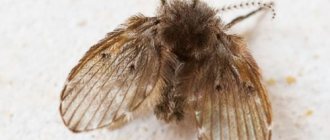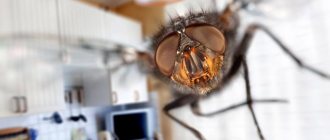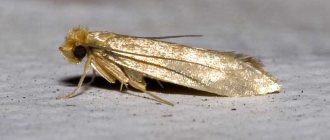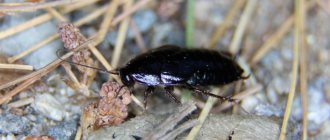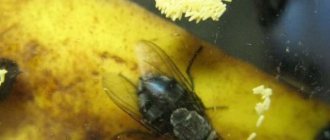Have you ever seen your kitchen infested with insects that appeared out of nowhere? Fruit gnats are a common nuisance in the kitchen and are especially active in late fall and summer when there is a lot of food to eat. They are also called fruit flies, vinegar flies, and wine flies.
Pests are attracted to the orange peel of fruit left on the countertop, tomatoes ripening on the windowsill, bananas, a bowl of fruit, lettuce left in the sink. Creatures the size of a pinhead don't bite. They are an alarming sight, lazily circling around.
Due to their small size, fruit flies can enter the house from the outside through the window. They are brought to the kitchen with products purchased at the market or store. Learn how to get rid of fruit gnats using time-tested, organic and natural methods.
Where do they come from?
Until the 18th century, scientists believed in a phenomenon called "spontaneous generation", suggesting that fruit gnats naturally reproduced from inorganic, dirty materials such as dirty laundry and rotting meat. Contrary to popular belief, this is not a case of spontaneous reproduction.
They can live almost anywhere. Even the cleanest kitchens look attractive.
Leaving out fresh food is like advertising free room and board for pests. As a rule, they get on fruit brought from the store or through open doors and windows.
Fruit flies breed anywhere there is moist, decaying organic matter. This includes sink drains (the dark, larger pests known as drain flies), trash cans, compost, tile grout, even wash rags. Since they can reproduce in many places, these nasty insects are difficult to eradicate.
If you don't provide fruit gnats with a place to breed by using thorough cleaning methods, spray pesticides as much as you like. The pest will return.
Preventing flies from entering your home
There are many ways to prevent the development of fruit flies in the home:
- Wash the purchased fruits thoroughly, it is advisable to even pour boiling water over them and dry them thoroughly (wet fruits and vegetables spoil faster);
- dispose of very soft fruits that are beginning to rot;
- quickly eat perishable fruits, berries and vegetables (peaches, strawberries, etc.);
- do not leave fruits on the table (especially chopped or peeled);
- put food in the refrigerator;
- take out the garbage on time, and the waste bin should have a lid that fits tightly to the rim;
- do not hoard dirty dishes;
- frequently check fruits and berries for spoilage and throw away those that are beginning to rot;
- Clean the house regularly.
But if prevention for some reason does not save you, there is nothing else left but to begin an active fight against fruit flies.
What they look like
It is important to make sure that the insect you see is actually a fruit fly.
Fruit midges belong to the family Drosophilidae . Common species include Drosophila melanogaster (common fruit fly) and Drosophila suzukii (Asian fruit fly). These insects are very small (about two to four millimeters long) and vary in color from yellow to brown to black.
The belly may be dark, even black with transverse rings. The main distinguishing feature is red eyes. They are found throughout the world, but are more common in tropical areas with humid climates.
There are several pests that are constantly mistaken for fruit gnats (but more on that later).
Let's remember biology: types of fruit flies
The insect is harmless, although annoying. Scientists count several thousand species, although only 1,500 of them are described in detail, 40 live in European countries.
Drosophila melanogaster (other names: fruit fly, fruit fly, small fly, wood sorrel) is a small, approximately 3 mm in length, insect belonging to the family Drosophiliadae, order Diptera. External characteristics: red eyes and brown-yellow coloration with black rings on the abdomen. The female's body is approximately 2.5 mm, while the male is smaller and has a darker rear. It is these midges that usually appear in houses and apartments.
By the way, the melanogaster subspecies is highly valued by geneticists because it is ideal for experiments.
And especially for aquarists, a wingless subtype has been bred, which is used to feed fish and reptiles.
Drosophila funebris (called the large or vinegar fly) is larger than melanogaster by an average of 1 mm. It lives mainly near ponds, barrels or other vessels with fermenting/rotting liquids, and less often found in fruits.
Life cycle
The female lays 500 – 2000 eggs at a time, usually on or near fermented fruit or other decaying organic material. Eggs contained in wet secretions live on the peel, pulp of fruits, and other damp places.
Find out more Ultrasonic repellers of rodents and insects - pros and cons
They hatch in 12–15 hours. The resulting larvae grow for 4 days (at 25°C). They feed for five or more days on yeasts produced on plant matter, then move to a dry area to pupate.
It is interesting to note that fruit fly pupae do not eat. This developmental time occurs away from their food source and breeding site, so the extra nutrients accumulated during the larval stage are used to fuel their changing bodies.
Under optimal conditions (25°C), the lifespan of D. melanogaster is about 50 days from egg to death. The development period varies depending on temperature. The shortest development time (from egg to adult), 7 days, is achieved at 28°C.
Development time increases at higher temperatures (11 days at 30°C) due to heat stress. Under ideal conditions (25°C) the life cycle is 8.5 days, at 18°C – 19 days, at 12°C – more than 50 days. They take two days to become mature. They mate twice in a short life.
D. melanogaster is used for life extension research, such as identifying genes designed to increase lifespan when mutated.
Mining flies on vegetables
Mining flies can cause serious damage to plant leaves. The main danger of these vegetable midges is due to their very short life cycle (about 25 days). This means that 4-5 generations of incredibly voracious little pests appear per season.
Female leaf miners pierce plant tissue to suck sap or lay eggs. In addition, by piercing the surface of the leaf, they are able to transmit pathogens of various diseases.
Consequences
Causes and signs of appearance
The main causes of infection are planting plants close to each other and the lack of preventive measures.
The first sign of damage is puncture marks left by female leaf miners. Further on the leaf, light stains become noticeable, which are the passages of the larvae.
How to fight?
In open ground, the chemical method is most often used. Spray products containing pyrethrum work effectively. Treatment is carried out 5-6 times with an interval of three to five days.
Traditional methods are effective for small infestations. They are similar to those used to control other pests, for example, cabbage fly.
Signs of the appearance of cabbage fly and methods of combating it
Signs of the presence of cabbage fly larvae in the roots of the plant are stunted growth and wilting of the leaves. Midge larvae in cabbage can destroy a crop in just a couple of weeks. The fight against them must begin immediately after their discovery.
Methods to combat cabbage fly:
- eliminating all cabbage residues from the garden after harvesting;
- correct crop rotation - do not plant cruciferous crops in the same place;
- a ban on the use of garden soil for growing seedlings;
- soaking the seeds for 1-2 hours in a slightly pink solution of potassium permanganate;
- regular digging of beds;
- covering seedlings after planting;
- the use of insecticides and folk remedies if preventive measures did not help and infection occurred.
How to get rid of fruit gnats
Block insects' access to decaying organic matter. It's not as simple as it seems. In addition to being found on fruit plates and kitchen surfaces, they breed in drains, around sinks, on mops, damp wood, behind walls, and on the edges of cans and bottles.
Do not store food closed. Refrigerate fruits, vegetables, (especially) bananas. This is a good practice to prevent the introduction and spread of a home invader. Cooling is absolutely essential when controlling an established infestation.
Find out more The structure and life of an anthill, how it works, features
Discard vegetable waste immediately during cooking. If kitchen scraps, including citrus fruits and banana peels, end up in the trash, place the bag in the freezer until you are ready to throw it away. Banana peels left open overnight are especially attractive to flies.
Clean and dry the food preparation area thoroughly.
Make sure trash cans have closed, tight-fitting lids. Keep jars clean inside and out, including the tops.
Wash used containers thoroughly, especially fruit juice bottles and soda cans.
Think pests are coming out of your sink? Cover it with plastic wrap overnight and check in the morning for flies. Keep drains clean using special products.
Mix equal parts baking soda and salt, then add an equal amount of white vinegar to help clean your pipes.
The Department of Entomology says there is no benefit to pouring bleach or ammonia down the drain to kill insects.
Wooden cutting boards may contain eggs and larvae. Wash them frequently in hot water and let them dry completely.
Check for water leaks under and around the sink. Fruit midges lay eggs on any moist organic surface, especially under shells.
Traps
Use traps to lure and capture adult pests. Some are specifically designed for indoor use.
Make one or more homemade vinegar traps. Place them around food storage and preparation areas. Roll a cone out of half a sheet of paper, leaving a small hole at the bottom. Insert the cone into a jar with apple cider vinegar poured into the bottom.
The flies descend the cone towards the vinegar, but once inside, they cannot find a way out; they circle around the edge of the jar, wondering how they got there. Make sure the cone fits snugly against the edge of the jar (coat the edges with oil, which will prevent insects from escaping).
Humanists can take the jar outside, remove the cone, and release the surviving pests.
A piece of plastic wrap with tiny holes placed on a fruit cup is also a quick and effective way to catch circling fruit flies. Traps work with beer and wine. Yeast is attracted by fermentation.
If pests are present despite your best efforts, look for hidden breeding sites, such as spoiled potatoes or juice spills under a cabinet or refrigerator.
- Fruit gnats can breed in trays placed under houseplants. Clean them after watering. Houseplants may be infested with another type of small insect
Replacing your window screen with a fine mesh screen will help prevent pests from entering from the street.
Lavender has been shown to prevent fruit flies. Basil, mint, and thyme turned out to be more attractive to pests than banana slices.
Cloves repel small insects. Stick at least 25 cloves into a fresh lemon and place on top of a bowl of fruit.
Find out more 10 pests of indoor plants, how to deal with them
Other ways to fight
To get rid of midges, you often use sticky tape, which can be purchased at any hardware store. Such a trap is excellent for removing these insects - attracted by the pleasant sweet aroma, they sit on the tape and stick to it.
You can also get rid of midges that prefer rotten fruit using mechanical methods. This could be, for example, through ventilation. A small part of the insects may hide, but the bulk will end up outside the room.
In addition, you can get rid of them using a vacuum cleaner , but to do this you must first remove the wide nozzle. Then the vacuum cleaner container is taken out as far as possible from the house and its contents are shaken out into a bag, tied and thrown into the garbage chute.
Various incense also help remove midges. The most effective scents are those emitted by verbena, patchouli and ylang-ylang sticks. If you add 3-5 drops of clove oil to a lit aroma lamp, this will destroy all insects, including mosquitoes and fruit flies. Some housewives use ordinary candles with strong odors or spray a citrus or pine air freshener into the air.
Biting flies
These are tiny flies that live throughout the world and cause painful bites to people and animals. Black midges attack quickly and effectively, remaining undetected once they have bitten.
Although these insects do not usually transmit disease, it is not impossible to get the bacteria from their mouths. The symptoms are a painful red patch on the skin that goes away naturally after a few days.
If you can see a small insect hopping around, you are looking at a tick or flea. These parasites are unique in that they do not have wings, but they do have the incredible ability to jump up to 20 cm in height. For an insect measuring about 2 millimeters, this is a feat.
In addition, ticks and fleas feed exclusively on blood. Fruit flies also like to snack on organic matter, the food groups are completely different. Fleas and ticks feed by biting a living host and extracting blood, fruit flies drink fruit juice.
These pests are disgusting, but they don't spread disease or bite through your skin.
Fruit flies don't have teeth or cutting tools, so the worst they'll do is be an irritant.
Flies belonging to the family Tephritidae are also called fruit flies. This causes confusion, especially in the Mediterranean, Australia, South Africa, where the Mediterranean fruit fly Ceratitis capitata is a pest.
Similarities with people
A March 2000 study by the National Human Genome Research Institute comparing the fruit fly and the human genome found that about 60% of the genes were the same.
About 75% of known human disease genes have a recognizable match in the fruit midge genome. Drosophila is used as a genetic model for a number of human diseases:
- neurodegenerative disorders;
- Parkinson's, Huntington's disease;
- spinocerebellar ataxia;
- Alzheimer's disease.
The fly is used to study the mechanisms underlying aging, oxidative stress, immunity, diabetes, cancer, drug abuse.
